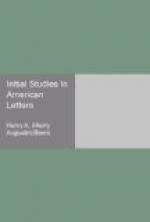Of poetry, indeed, or, in fact, of pure literature, in the narrower sense—that is, of the imaginative representation of life—there was little or none in the colonial period. There were no novels, no plays, no satires, and—until the example of the Spectator had begun to work on this side the water—no experiments even at the lighter forms of essay-writing, character-sketches, and literary criticism. There was verse of a certain kind, but the most generous stretch of the term would hardly allow it to be called poetry. Many of the early divines of New England relieved their pens, in the intervals of sermon-writing, of epigrams, elegies, eulogistic verses, and similar grave trifles distinguished by the crabbed wit of the so-called “metaphysical poets,” whose manner was in fashion when the Puritans left England; the manner of Donne and Cowley, and those darlings of the New-English muse, the Emblems of Quarles and the Divine Week of Du Bartas, as translated by Sylvester. The Magnalia contains a number of these things in Latin and English, and is itself well bolstered with complimentary introductions in meter by the author’s friends. For example:
COTTONIUS MATHERUS.
ANAGRAM.
Tuos Tecum Ornasti.
“While thus the dead in thy rare pages rise Thine, with thyself thou dost immortalize. To view the odds thy learned lives invite ’Twixt Eleutherian and Edomite. But all succeeding ages shall despair A fitting monument for thee to rear. Thy own rich pen (peace, silly Momus, peace!) Hath given them a lasting writ of ease.”
The epitaphs and mortuary verses were especially ingenious in the matter of puns, anagrams, and similar conceits. The death of the Rev. Samuel Stone, of Hartford, afforded an opportunity of this sort not to be missed, and his threnodist accordingly celebrated him as a “whetstone,” a “loadstone,” an “Ebenezer”—
“A stone for kingly David’s
use so fit
As would not fail Goliath’s front
to hit,” etc.
The most characteristic, popular, and widely circulated poem of colonial New England was Michael Wigglesworth’s Day of Doom (1663), a kind of doggerel Inferno, which went through nine editions, and “was the solace,” says Lowell, “of every fireside, the flicker of the pine-knots by which it was conned perhaps adding a livelier relish to its premonitions of eternal combustion.” Wigglesworth had




